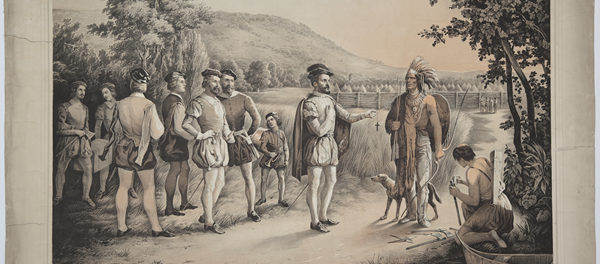1534: Everything You Wanted to Know about Cartier & Other Quebec Curios
Je me souviens: New France, 1534–1763
Unlike the Italian Giovanni Caboto, whose name was anglicised into John Cabot, Jacques Cartier was French, born in Saint-Malo, one year before Columbus is said to have made his famous voyage to the West Indies. Little else is known about Cartier’s life before he undertook his voyages for the French kingdom, though he would have probably gained his sailing and navigation experience as a sailor.
Cartier’s list of previous explorations prior to 1534 are sketchy and nobody can seem to agree one where he may have been during his absences from France: some people believe that in the 1520s, he was on the same ship as Giovanni Verrazano; others believe he may have been in Normandy during his absence. Neither theory has yet been proven or disproven: his name does not appear on the crew list of either voyage. However, in 1534, fortune would fall onto Cartier: he would be called upon by the French king, François the First, to man a voyage to New France. Apparently, the decision as to who would lead the voyage seemed to be a toss-up between Cartier or Verrazano, but the latter had been eaten by cannibals in Guadeloupe during his last voyage, so the king was left only one option.
With a crew of sixty-one men (perhaps counting some of Verrazano’s traumatised crew whose names are lost to history), Cartier embarked on his voyage in 1534. Cartier and his team set afloat on the Grande Hermine and the Petite Hermine, and later joined by the Émérillon and another sixty people, Cartier’s first voyage took about twenty days to cross the Atlantic Ocean. Cartier’s first voyage would go around the Gulf of the Saint Lawrence, but his second journey, in 1535, would take him into the Saint Lawrence River and its treacherous rapids. Cartier’s third voyage, intended to build a settlement, was met with failure. Cartier’s explorations, until the end, were chiefly economic, his hunt was the hunt for alternative route to Asia. On his way exploring what he thought was the path to China, he encountered and, more importantly, charted, new regions and claimed them for France. Along the way, he also had an ego trip and named a harbour after himself: the Jacques Cartier harbour (probably now the Cumberland Harbour).
Cartier is one of the first of the people involved in European contact with the Amerindians. He would first come into contact with chief Donnacona and his sons, Iroquois leaders. Springing from the fact that Cartier wanted to bring Donnacona and his sons back to France, Cartier’s actions would bring about the rise of Donnacona’s rival, Agora, in his community, fuelling the bitterness between the French and the Iroquois that would continue for many years.
The place where Jacques Cartier is purported to have planted the famous cross for the Kingdom of France is the Saint Servan Port (now known as Lobster Bay). During his second voyage, he was forced to turn back because of the rapids in the Saint Lawrence River: where he landed now stands none other than the Jacques Cartier bridge.






